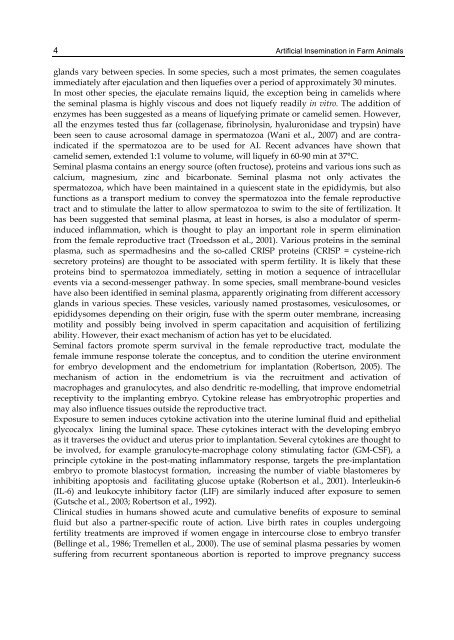ARTIFICIAL INSEMINATION IN FARM ANIMALS - Phenix-Vet
ARTIFICIAL INSEMINATION IN FARM ANIMALS - Phenix-Vet
ARTIFICIAL INSEMINATION IN FARM ANIMALS - Phenix-Vet
Create successful ePaper yourself
Turn your PDF publications into a flip-book with our unique Google optimized e-Paper software.
4Artificial Insemination in Farm Animalsglands vary between species. In some species, such a most primates, the semen coagulatesimmediately after ejaculation and then liquefies over a period of approximately 30 minutes.In most other species, the ejaculate remains liquid, the exception being in camelids wherethe seminal plasma is highly viscous and does not liquefy readily in vitro. The addition ofenzymes has been suggested as a means of liquefying primate or camelid semen. However,all the enzymes tested thus far (collagenase, fibrinolysin, hyaluronidase and trypsin) havebeen seen to cause acrosomal damage in spermatozoa (Wani et al., 2007) and are contraindicatedif the spermatozoa are to be used for AI. Recent advances have shown thatcamelid semen, extended 1:1 volume to volume, will liquefy in 60-90 min at 37°C.Seminal plasma contains an energy source (often fructose), proteins and various ions such ascalcium, magnesium, zinc and bicarbonate. Seminal plasma not only activates thespermatozoa, which have been maintained in a quiescent state in the epididymis, but alsofunctions as a transport medium to convey the spermatozoa into the female reproductivetract and to stimulate the latter to allow spermatozoa to swim to the site of fertilization. Ithas been suggested that seminal plasma, at least in horses, is also a modulator of sperminducedinflammation, which is thought to play an important role in sperm eliminationfrom the female reproductive tract (Troedsson et al., 2001). Various proteins in the seminalplasma, such as spermadhesins and the so-called CRISP proteins (CRISP = cysteine-richsecretory proteins) are thought to be associated with sperm fertility. It is likely that theseproteins bind to spermatozoa immediately, setting in motion a sequence of intracellularevents via a second-messenger pathway. In some species, small membrane-bound vesicleshave also been identified in seminal plasma, apparently originating from different accessoryglands in various species. These vesicles, variously named prostasomes, vesiculosomes, orepididysomes depending on their origin, fuse with the sperm outer membrane, increasingmotility and possibly being involved in sperm capacitation and acquisition of fertilizingability. However, their exact mechanism of action has yet to be elucidated.Seminal factors promote sperm survival in the female reproductive tract, modulate thefemale immune response tolerate the conceptus, and to condition the uterine environmentfor embryo development and the endometrium for implantation (Robertson, 2005). Themechanism of action in the endometrium is via the recruitment and activation ofmacrophages and granulocytes, and also dendritic re-modelling, that improve endometrialreceptivity to the implanting embryo. Cytokine release has embryotrophic properties andmay also influence tissues outside the reproductive tract.Exposure to semen induces cytokine activation into the uterine luminal fluid and epithelialglycocalyx lining the luminal space. These cytokines interact with the developing embryoas it traverses the oviduct and uterus prior to implantation. Several cytokines are thought tobe involved, for example granulocyte-macrophage colony stimulating factor (GM-CSF), aprinciple cytokine in the post-mating inflammatory response, targets the pre-implantationembryo to promote blastocyst formation, increasing the number of viable blastomeres byinhibiting apoptosis and facilitating glucose uptake (Robertson et al., 2001). Interleukin-6(IL-6) and leukocyte inhibitory factor (LIF) are similarly induced after exposure to semen(Gutsche et al., 2003; Robertson et al., 1992).Clinical studies in humans showed acute and cumulative benefits of exposure to seminalfluid but also a partner-specific route of action. Live birth rates in couples undergoingfertility treatments are improved if women engage in intercourse close to embryo transfer(Bellinge et al., 1986; Tremellen et al., 2000). The use of seminal plasma pessaries by womensuffering from recurrent spontaneous abortion is reported to improve pregnancy success










